1997 MERCEDES-BENZ ML430 coolant temperature
[x] Cancel search: coolant temperaturePage 3325 of 4133
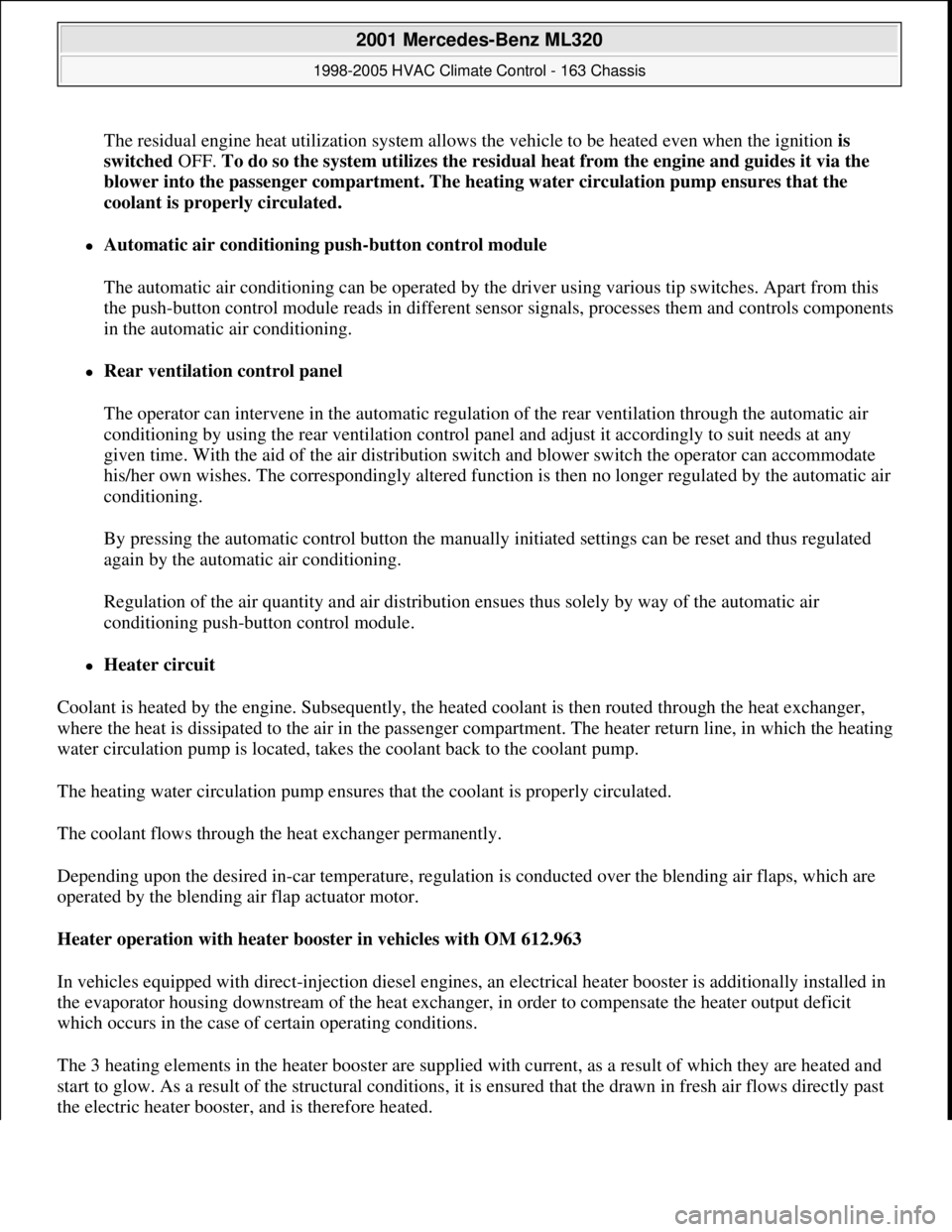
The residual engine heat utilization system allows the vehicle to be heated even when the ignition is
switched OFF. To do so the system utilizes the residual heat from the engine and guides it via the
blower into the passenger compartment. The heating water circulation pump ensures that the
coolant is properly circulated.
Automatic air conditioning push-button control module
The automatic air conditioning can be operated by the driver using various tip switches. Apart from this
the push-
button control module reads in different sensor signals, processes them and controls components
in the automatic air conditioning.
Rear ventilation control panel
The operator can intervene in the automatic regulation of the rear ventilation through the automatic air
conditioning by using the rear ventilation control panel and adjust it accordingly to suit needs at any
given time. With the aid of the air distribution switch and blower switch the operator can accommodate
his/her own wishes. The correspondingly altered function is then no longer regulated by the automatic air
conditioning.
By pressing the automatic control button the manually initiated settings can be reset and thus regulated
again by the automatic air conditioning.
Regulation of the air quantity and air distribution ensues thus solely by way of the automatic air
conditioning push-button control module.
Heater circuit
Coolant is heated by the engine. Subsequently, the heated coolant is then routed through the heat exchanger,
where the heat is dissipated to the air in the passenger compartment. The heater return line, in which the heating
water circulation pump is located, takes the coolant back to the coolant pump.
The heating water circulation pump ensures that the coolant is properly circulated.
The coolant flows through the heat exchanger permanently.
Depending upon the desired in-car temperature, regulation is conducted over the blending air flaps, which are
operated by the blending air flap actuator motor.
Heater operation with heater booster in vehicles with OM 612.963
In vehicles equipped with direct-injection diesel engines, an electrical heater booster is additionally installed in
the evaporator housing downstream of the heat exchanger, in order to compensate the heater output deficit
which occurs in the case of certain operating conditions.
The 3 heating elements in the heater booster are supplied with current, as a result of which they are heated and
start to glow. As a result of the structural conditions, it is ensured that the drawn in fresh air flows directly past
the electric heater booster, and is therefore heated.
2001 Mercedes-Benz ML320
1998-2005 HVAC Climate Control - 163 Chassis
me
Saturday, October 02, 2010 3:23:16 PMPage 81 © 2006 Mitchell Repair Information Company, LLC.
Page 3341 of 4133
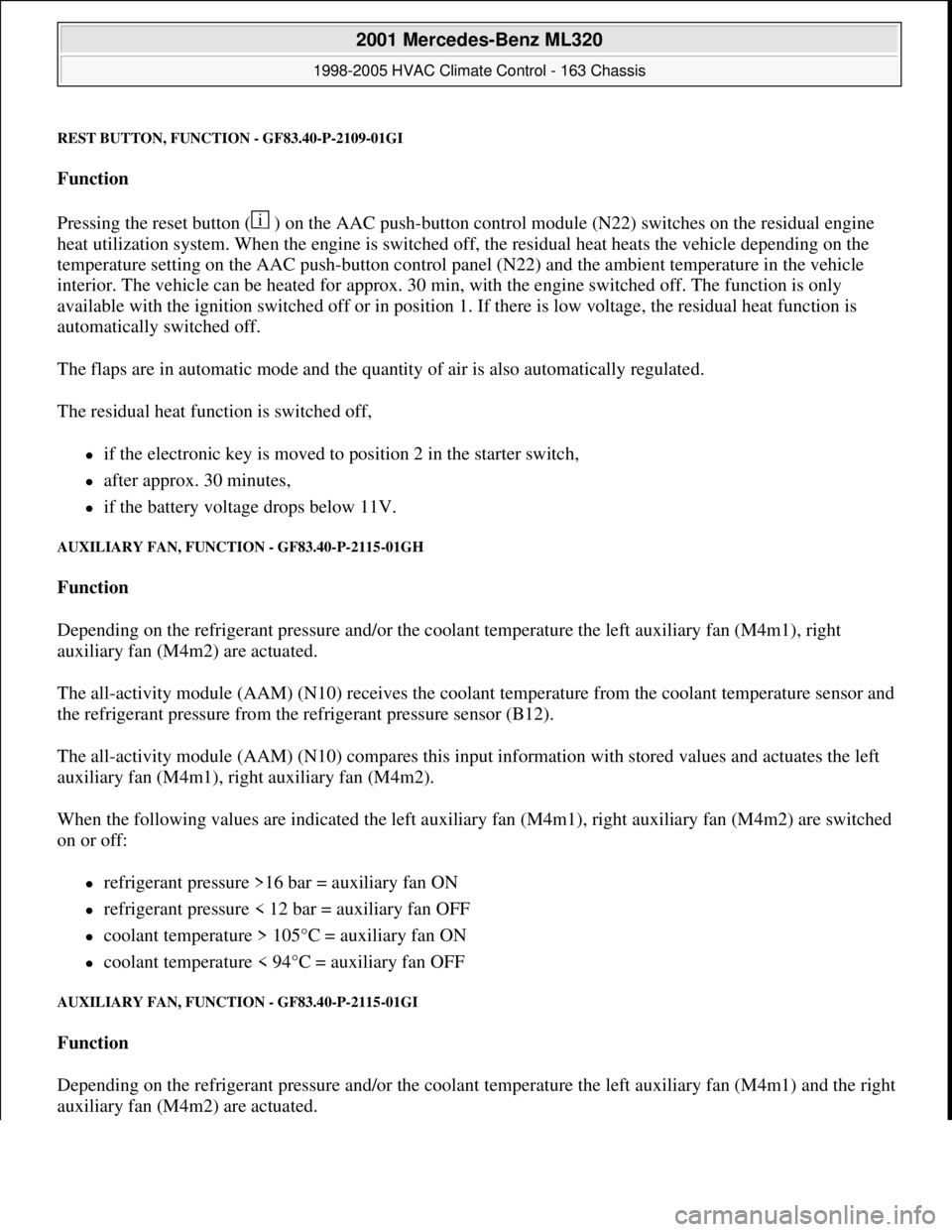
REST BUTTON, FUNCTION - GF83.40-P-2109-01GI
Function
Pressing the reset button ( ) on the AAC push-button control module (N22) switches on the residual engine
heat utilization system. When the engine is switched off, the residual heat heats the vehicle depending on the
temperature setting on the AAC push-button control panel (N22) and the ambient temperature in the vehicle
interior. The vehicle can be heated for approx. 30 min, with the engine switched off. The function is only
available with the ignition switched off or in position 1. If there is low voltage, the residual heat function is
automatically switched off.
The flaps are in automatic mode and the quantity of air is also automatically regulated.
The residual heat function is switched off,
if the electronic key is moved to position 2 in the starter switch,
after approx. 30 minutes,
if the battery voltage drops below 11V.
AUXILIARY FAN, FUNCTION - GF83.40-P-2115-01GH
Function
Depending on the refrigerant pressure and/or the coolant temperature the left auxiliary fan (M4m1), right
auxiliary fan (M4m2) are actuated.
The all-activity module (AAM) (N10) receives the coolant temperature from the coolant temperature sensor and
the refrigerant pressure from the refrigerant pressure sensor (B12).
The all-activity module (AAM) (N10) compares this input information with stored values and actuates the left
auxiliary fan (M4m1), right auxiliary fan (M4m2).
When the following values are indicated the left auxiliary fan (M4m1), right auxiliary fan (M4m2) are switched
on or off:
refrigerant pressure >16 bar = auxiliary fan ON
refrigerant pressure < 12 bar = auxiliary fan OFF
coolant temperature > 105°C = auxiliary fan ON
coolant temperature < 94°C = auxiliary fan OFF
AUXILIARY FAN, FUNCTION - GF83.40-P-2115-01GI
Function
Depending on the refrigerant pressure and/or the coolant temperature the left auxiliary fan (M4m1) and the right
auxiliary fan (M4m2) are actuated.
2001 Mercedes-Benz ML320
1998-2005 HVAC Climate Control - 163 Chassis
me
Saturday, October 02, 2010 3:23:16 PMPage 97 © 2006 Mitchell Repair Information Company, LLC.
Page 3342 of 4133

The all-activity module (AAM) (N10) receives the coolant temperature by the coolant temperature sensor
(B11/4) and the refrigerant pressure by the refrigerant pressure and temperature sensor (B12/2). The all-activity
module (AAM) (N10) compares this input information with stored values and actuates the left auxiliary fan
(M4m1) and the right auxiliary fan (M4m2).
When the following values are indicated the left auxiliary fan (M4m1), right auxiliary fan (M4m2) are switched
on or off:
refrigerant pressure >16 bar = auxiliary fan ON
refrigerant pressure <13 bar = auxiliary fan OFF
coolant temperature > 105°C = auxiliary fan ON
coolant temperature < 97°C = auxiliary fan OFF
AUXILIARY FAN, LOCATION - GF83.40-P-2115-02GH
The auxiliary fans are located (M4) directly in front of the condenser.
Fig. 79: Identifying Left Auxiliary Fan And Right Additional Fan
ENGINE/AIR CONDITIONING ELECTRIC FAN, FUNCTION - GF83.40-P-2118-01GH
Function
Depending on the refrigerant pressure and/or the coolant temperature the fan speed is increased infinitely.
Engines 612.963 and 628.963
The CDI control module (N3/9) receives the coolant temperature from the coolant temperature sensor and via
the all-activity module (AAM) (N10) via the CAN bus the refrigerant pressure from the refrigerant pressure
sensor (B12).
2001 Mercedes-Benz ML320
1998-2005 HVAC Climate Control - 163 Chassis
me
Saturday, October 02, 2010 3:23:16 PMPage 98 © 2006 Mitchell Repair Information Company, LLC.
Page 3343 of 4133
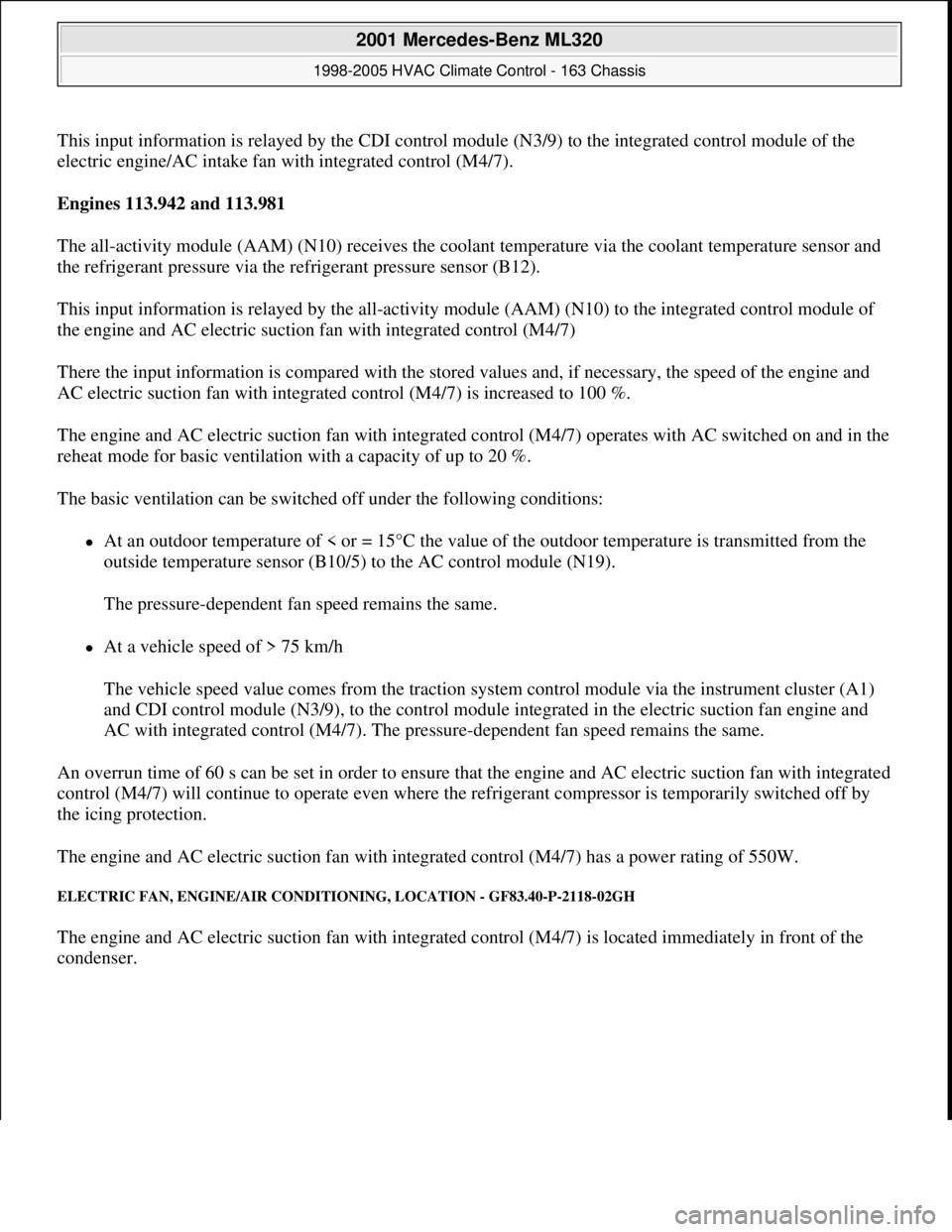
This input information is relayed by the CDI control module (N3/9) to the integrated control module of the
electric engine/AC intake fan with integrated control (M4/7).
Engines 113.942 and 113.981
The all-activity module (AAM) (N10) receives the coolant temperature via the coolant temperature sensor and
the refrigerant pressure via the refrigerant pressure sensor (B12).
This input information is relayed by the all-activity module (AAM) (N10) to the integrated control module of
the engine and AC electric suction fan with integrated control (M4/7)
There the input information is compared with the stored values and, if necessary, the speed of the engine and
AC electric suction fan with integrated control (M4/7) is increased to 100 %.
The engine and AC electric suction fan with integrated control (M4/7) operates with AC switched on and in the
reheat mode for basic ventilation with a capacity of up to 20 %.
The basic ventilation can be switched off under the following conditions:
At an outdoor temperature of < or = 15°C the value of the outdoor temperature is transmitted from the
outside temperature sensor (B10/5) to the AC control module (N19).
The pressure-dependent fan speed remains the same.
At a vehicle speed of > 75 km/h
The vehicle speed value comes from the traction system control module via the instrument cluster (A1)
and CDI control module (N3/9), to the control module integrated in the electric suction fan engine and
AC with integrated control (M4/7). The pressure-dependent fan speed remains the same.
An overrun time of 60 s can be set in order to ensure that the engine and AC electric suction fan with integrated
control (M4/7) will continue to operate even where the refrigerant compressor is temporarily switched off by
the icing protection.
The engine and AC electric suction fan with integrated control (M4/7) has a power rating of 550W.
ELECTRIC FAN, ENGINE/AIR CONDITIONING, LOCATION - GF83.40-P-2118-02GH
The engine and AC electric suction fan with integrated control (M4/7) is located immediately in front of the
condenser.
2001 Mercedes-Benz ML320
1998-2005 HVAC Climate Control - 163 Chassis
me
Saturday, October 02, 2010 3:23:16 PMPage 99 © 2006 Mitchell Repair Information Company, LLC.
Page 3354 of 4133
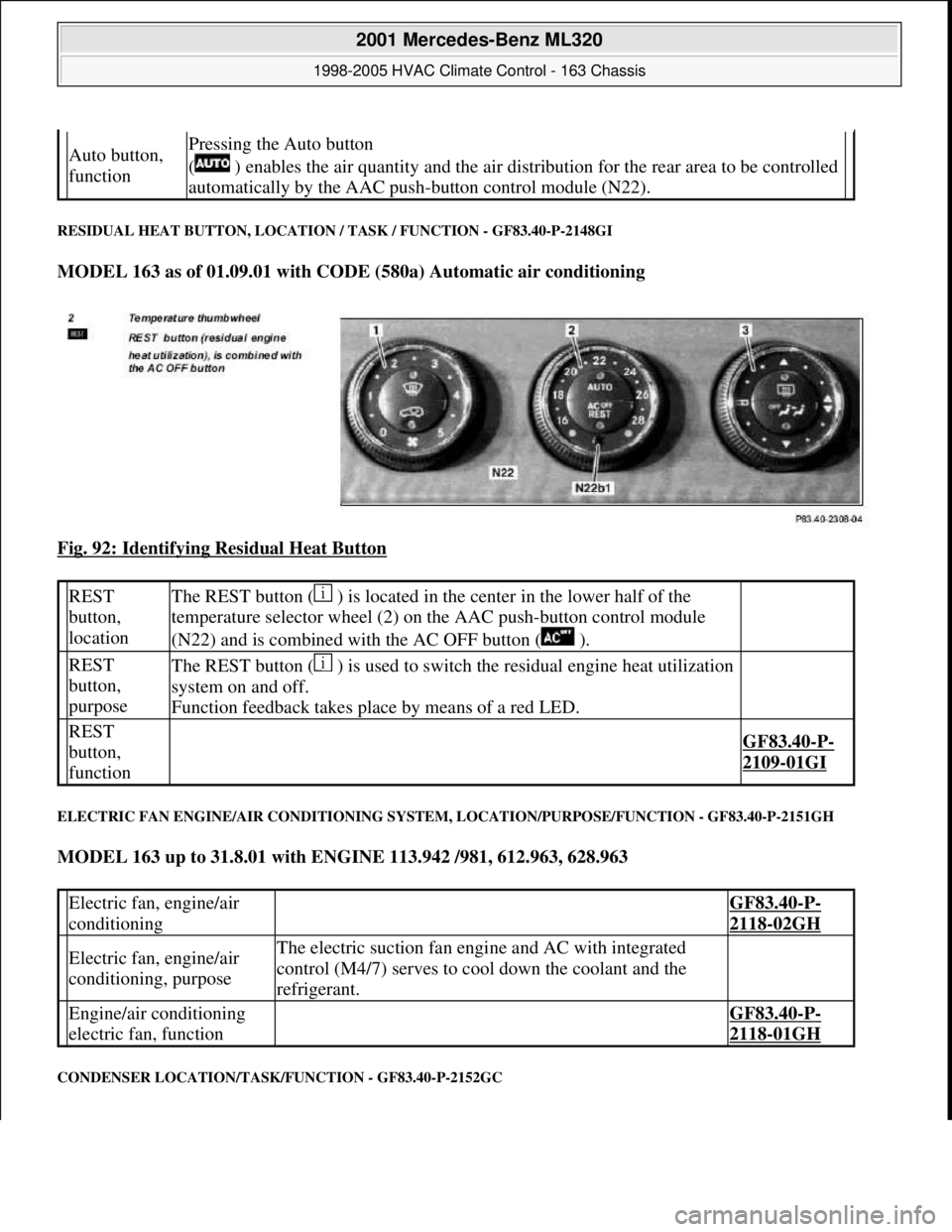
RESIDUAL HEAT BUTTON, LOCATION / TASK / FUNCTION - GF83.40-P-2148GI
MODEL 163 as of 01.09.01 with CODE (580a) Automatic air conditioning
Fig. 92: Identifying Residual Heat Button
ELECTRIC FAN ENGINE/AIR CONDITIONING SYSTEM, LOCATION/PURPOSE/FUNCTION - GF83.40-P-2151GH
MODEL 163 up to 31.8.01 with ENGINE 113.942 /981, 612.963, 628.963
CONDENSER LOCATION/TASK/FUNCTION - GF83.40-P-2152GC
Auto button,
functionPressing the Auto button
( ) enables the air quantity and the air distribution for the rear area to be controlled
automatically by the AAC push-button control module (N22).
REST
button,
locationThe REST button ( ) is located in the center in the lower half of the
temperature selector wheel (2) on the AAC push-button control module
(N22) and is combined with the AC OFF button ( ).
REST
button,
purposeThe REST button ( ) is used to switch the residual engine heat utilization
system on and off.
Function feedback takes place by means of a red LED.
REST
button,
function
GF83.40-P-
2109-01GI
Electric fan, engine/air
conditioning GF83.40-P-
2118-02GH
Electric fan, engine/air
conditioning, purposeThe electric suction fan engine and AC with integrated
control (M4/7) serves to cool down the coolant and the
refrigerant.
Engine/air conditioning
electric fan, function GF83.40-P-
2118-01GH
2001 Mercedes-Benz ML320
1998-2005 HVAC Climate Control - 163 Chassis
me
Saturday, October 02, 2010 3:23:16 PMPage 110 © 2006 Mitchell Repair Information Company, LLC.
Page 3357 of 4133

MODEL 163 as of 1.9.01 with ENGINE 112.942 /970 with CODE (580a) Automatic air conditioning
REFRIGERANT PRESSURE AND TEMPERATURE SENSOR, FUNCTION - GF83.40-P-2171-01GI
Detecting the refrigerant pressure
The refrigerant pressure and temperature sensor (B12/2) detects the refrigerant pressure and sends the
determined value via the CAN-BUS to the AAC push-button control module (N22). This value is compared
with a stored temperature/pressure curve.
The refrigerant pressure and temperature sensor (B12/2) operates in a pressure value range of from 0 to 35 bar.
Shutting of the refrigerant compressor
At the following values, the refrigerant compressor is switched off.
refrigerant pressure < 1.75 bar = refrigerant compressor OFF
refrigerant pressure > 30 bar = refrigerant compressor OFF
Switching on the refrigerant compressor
The refrigerant compressor is switched on at the following value
refrigerant pressure > 2.25 bar = refrigerant compressor ON
Detecting the refrigerant temperature
The refrigerant pressure and temperature sensor (B12/2) detects the temperature of the refrigerant and sends the
determined value via the CAN-BUS to the AAC push-button control module (N22). This value is compared
with a stored temperature/pressure curve and the refrigerant level is determined as a result.
With a refrigerant level that is too low, the refrigerant compressor is switched off by the AAC push-button
control module (N22) via the CAN-BUS.
The AC OFF mode is activated and can no longer be quit. Only when the error has been eliminated and the
diagnostic trouble code memory in the AAC push-button control module (N22) has been erased will the system
be operational again.
Auxiliary fan,
location GF83.40-P-2115-
02GH
Auxiliary fan,
purposeThe left auxiliary fan (M4m1) and right auxiliary fan (M4m2) serve
for cooling the coolant and the refrigerant.
Auxiliary fan,
functionup to 31.08.01GF83.40-P-2115-
01GH
as of 1.09.01GF83.40-P-2115-
01GI
2001 Mercedes-Benz ML320
1998-2005 HVAC Climate Control - 163 Chassis
me
Saturday, October 02, 2010 3:23:16 PMPage 113 © 2006 Mitchell Repair Information Company, LLC.
Page 3359 of 4133
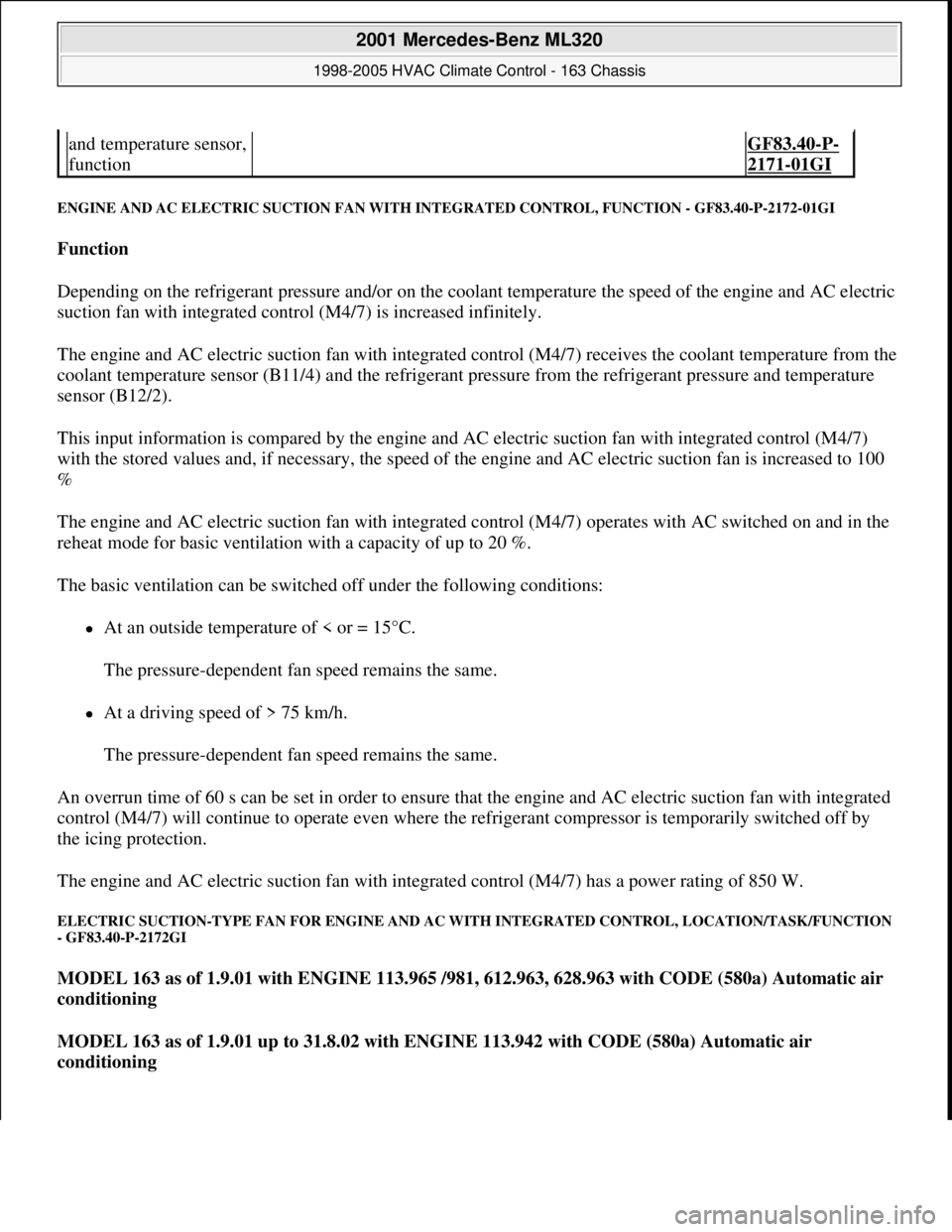
ENGINE AND AC ELECTRIC SUCTION FAN WITH INTEGRATED CONTROL, FUNCTION - GF83.40-P-2172-01GI
Function
Depending on the refrigerant pressure and/or on the coolant temperature the speed of the engine and AC electric
suction fan with integrated control (M4/7) is increased infinitely.
The engine and AC electric suction fan with integrated control (M4/7) receives the coolant temperature from the
coolant temperature sensor (B11/4) and the refrigerant pressure from the refrigerant pressure and temperature
sensor (B12/2).
This input information is compared by the engine and AC electric suction fan with integrated control (M4/7)
with the stored values and, if necessary, the speed of the engine and AC electric suction fan is increased to 100
%
The engine and AC electric suction fan with integrated control (M4/7) operates with AC switched on and in the
reheat mode for basic ventilation with a capacity of up to 20 %.
The basic ventilation can be switched off under the following conditions:
At an outside temperature of < or = 15°C.
The pressure-dependent fan speed remains the same.
At a driving speed of > 75 km/h.
The pressure-dependent fan speed remains the same.
An overrun time of 60 s can be set in order to ensure that the engine and AC electric suction fan with integrated
control (M4/7) will continue to operate even where the refrigerant compressor is temporarily switched off by
the icing protection.
The engine and AC electric suction fan with integrated control (M4/7) has a power rating of 850 W.
ELECTRIC SUCTION-TYPE FAN FOR ENGINE AND AC WITH INTEGRATED CONTROL, LOCATION/TASK/FUNCTION
- GF83.40-P-2172GI
MODEL 163 as of 1.9.01 with ENGINE 113.965 /981, 612.963, 628.963 with CODE (580a) Automatic air
conditioning
MODEL 163 as of 1.9.01 up to 31.8.02 with ENGINE 113.942 with CODE (580a) Automatic air
conditioning
and temperature sensor,
function GF83.40-P-
2171-01GI
2001 Mercedes-Benz ML320
1998-2005 HVAC Climate Control - 163 Chassis
me
Saturday, October 02, 2010 3:23:16 PMPage 115 © 2006 Mitchell Repair Information Company, LLC.
Page 3381 of 4133
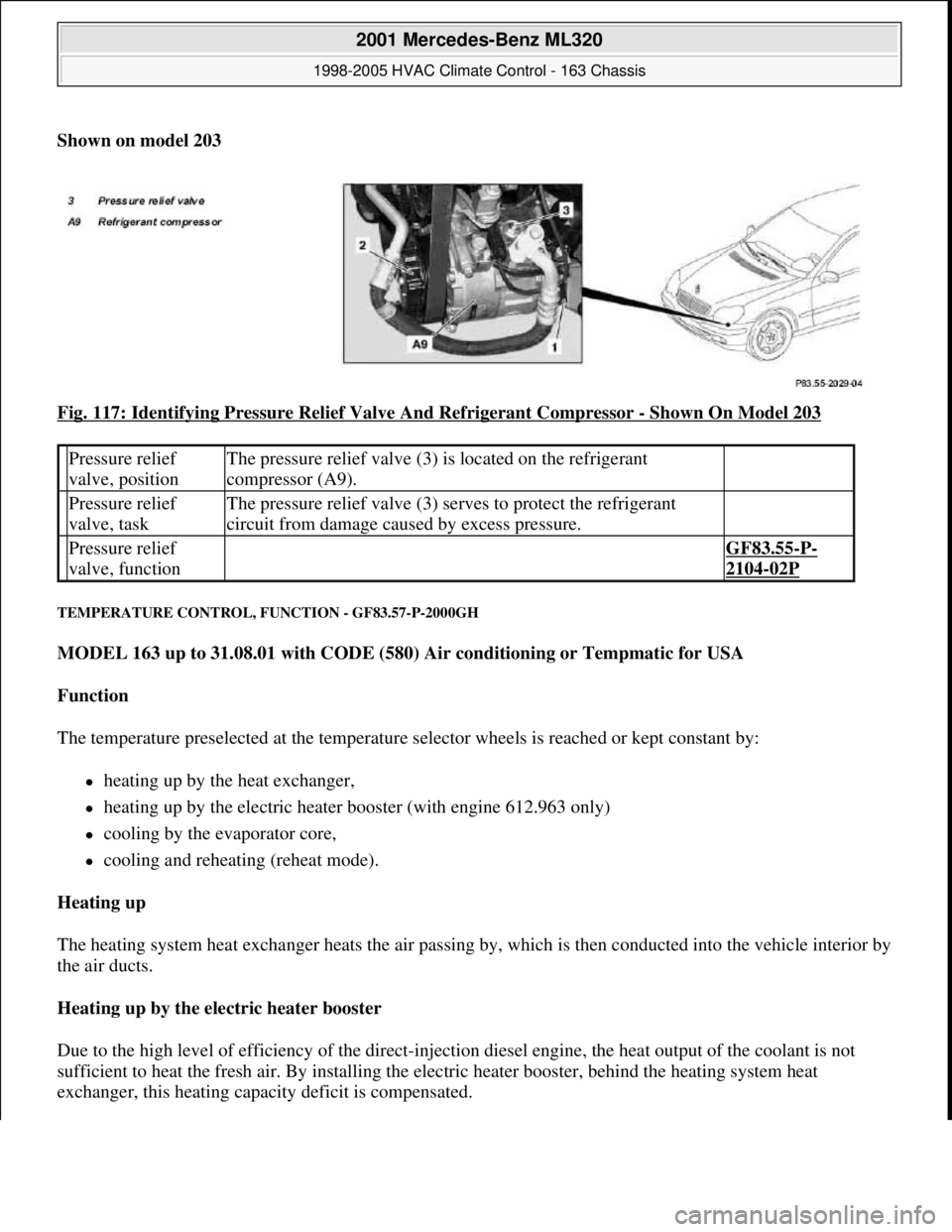
Shown on model 203
Fig. 117: Identifying Pressure Relief Valve And Refrigerant Compressor
- Shown On Model 203
TEMPERATURE CONTROL, FUNCTION - GF83.57-P-2000GH
MODEL 163 up to 31.08.01 with CODE (580) Air conditioning or Tempmatic for USA
Function
The temperature preselected at the temperature selector wheels is reached or kept constant by:
heating up by the heat exchanger,
heating up by the electric heater booster (with engine 612.963 only)
cooling by the evaporator core,
cooling and reheating (reheat mode).
Heating up
The heating system heat exchanger heats the air passing by, which is then conducted into the vehicle interior by
the air ducts.
Heating up by the electric heater booster
Due to the high level of efficiency of the direct-injection diesel engine, the heat output of the coolant is not
sufficient to heat the fresh air. By installing the electric heater booster, behind the heating system heat
exchanger, this heating capacity deficit is compensated.
Pressure relief
valve, positionThe pressure relief valve (3) is located on the refrigerant
compressor (A9).
Pressure relief
valve, taskThe pressure relief valve (3) serves to protect the refrigerant
circuit from damage caused by excess pressure.
Pressure relief
valve, function GF83.55-P-
2104-02P
2001 Mercedes-Benz ML320
1998-2005 HVAC Climate Control - 163 Chassis
me
Saturday, October 02, 2010 3:23:17 PMPage 137 © 2006 Mitchell Repair Information Company, LLC.